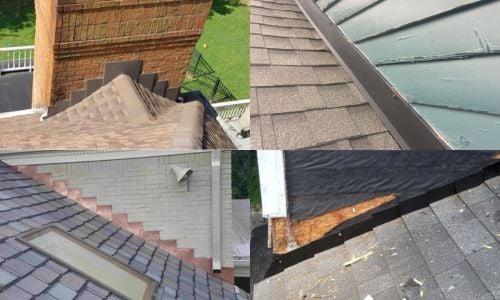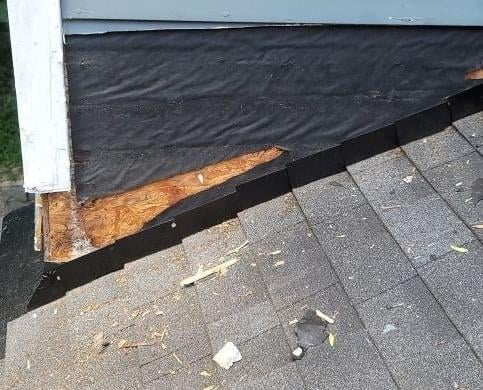Time for a roof replacement? Wondering if the flashing gets replaced when getting a new roof?
A roof replacement is literally tearing off your old roof and installing a new one. So, there are plenty of materials and components that need replacing.
However, roof flashing is a little different. So, the answer isn’t a straightforward yes or no.
For over 30 years, the team at Bill Ragan Roofing has helped homeowners understand everything that goes into replacing a roof. That’s why I’ll break down if flashing gets replaced during a roof replacement and much more.
By the end of this article, you’ll have the answers to:
- What is roof flashing?
- Does flashing get replaced during a roof replacement?
- Why wouldn’t a roofing contractor replace flashing during a roof replacement?
- What type of metal can be used for roof flashing?
What is roof flashing?
Roof flashing is metal installed to direct away and prevent water from getting into your home through areas vulnerable to leaks. It must be installed in places where shingles go against something (such as a wall, chimney, or open roof valleys) to completely seal the area.

It is one of the most crucial components every roof must have, and a leak is guaranteed to happen without it. However, the type of roof flashing used is based on the situation.
The four most common types of roof flashing in residential roofing are apron flashing, step flashing, counter flashing, and valley flashing.
Apron flashing
Apron flashing is used at the base of a wall or penetration. It’s shaped like an L and can be up to 14 feet long to fit the penetration’s base.

It’s also used around dormers to prevent water from getting into your windows.
Step flashing
Step flashing is primarily used against the sides of walls and chimneys. It works by placing a piece of metal (flashing) under every shingle installed right up against the side of a wall to block the water from running down into it.

That’s why the term “step” is used in step flashing. You do it step by step by installing a shingle, then a piece of flashing, then another shingle, then a piece of flashing until the wall is completely protected.
Counter flashing
Counter flashing is used on walls and chimneys, like step flashing. However, the metal is sawed into an existing mortar joint, and the metal comes over the top of the brick.

Like step flashing, counter flashing is sometimes installed in a step-by-step method. But it’s counter flashing if you can actually see it.
Roof valley flashing
Roof valleys are one of the most common roof areas prone to leaks because of the amount of water that flows through them. Because of this, they need the right type of material installed in them to prevent leaks.
 (Copper in an open valley on a cedar shake roof)
(Copper in an open valley on a cedar shake roof)
For open roof valleys specifically, they need metal valley flashing installed in the middle. Just know that this type of roof flashing is only installed in valleys of certain roofing materials that can’t bend to “close” a valley.
So, if you want certain luxury asphalt shingles (like Grand Manor or Carriage House), synthetic shingles, or cedar shakes, you’ll need flashing in the open valleys.
Does roof flashing get replaced during a roof replacement?
On most roofs, roof flashing can actually outlast the roofing material. It’s always a safe and good idea to replace the flashing during a roof replacement.
This provides peace of mind by knowing everything is brand new and freshly installed after the roof replacement. However, it also keeps your entire roof aging at the same rate.
However, it really depends on how it’s holding up when your roofer does their inspection. If the roof flashing is installed correctly with no rusting and the integrity of the metal is still strong, you may be able to reuse it.
It ultimately depends on what the roofer finds and if they’re willing to stand behind the previous contractor’s flashing work. But if it’s damaged, rusted, or if you’re upgrading to a new shingle type or another roofing material completely, it will need to be replaced.
Why wouldn’t a roofing contractor replace flashing during a roof replacement?
As you just learned, a roofing contractor may not replace flashing if the metal is holding strong and they’re happy with the previous installation. However, there are many cases in the roofing industry where flashing isn’t replaced when it should be.
This is mainly because bad roofing contractors leave it off their estimates to lower their prices. Metal is expensive, and replacing a lot of flashing can get pretty costly.
So, once a bad roofer knows a homeowner is looking for the cheapest price, the first things they try to exclude are replacement flashing, decking, and drip edge. This is just asking for premature roof failure and costly repairs.
To be safe, always expect your roof flashing to be replaced when getting a new roof. And if it’s not getting replaced, make sure the roofing contractor explains why.
What type of metal can be used for roof flashing?
Roof flashing can be made out of most metals, but the most commonly used types are aluminum, steel, or copper. The choice is completely up to you, but you need to consider your budget and the look you want for your new roof.
Steel is the most common type of metal used for flashing because of its clean look and affordability. If you want an upgraded look, copper roof flashing is a great option that’s considered a lifetime material.
It costs more upfront, but copper is a great match for the curb appeal of premium roofing materials. Aluminum is the cheapest option, but it’s also the least durable.
However, it still does the job if it’s installed correctly. Just talk with your roofing contractor and choose the metal that gives you the look you want while staying on budget.
What else needs to be replaced during a roof replacement?
Now you know what you need to know about roof flashing and if it gets replaced during a roof replacement. If you’re trying to save money and your roof flashing is in good shape, you may be able to get by without replacing it.
To be safe, expect your roof flashing to get replaced from the beginning. Just remember roof flashing is a crucial roofing component that every roof needs.
So, the important thing is that it’s in good condition and properly installed when getting a new roof. However, roof flashing isn’t the only important roofing component that every roof needs.
In fact, it’s just one small piece of the full puzzle. That’s why I wrote another article breaking down all the materials and components that should be included in a roof replacement.
Check out 9 Materials Included With Your Roof Replacement to learn everything that gets replaced when getting a new roof.



